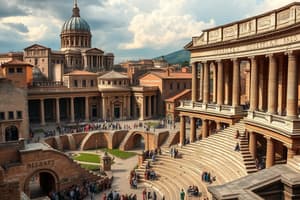Podcast
Questions and Answers
¿Cuál de las siguientes afirmaciones sobre la arquitectura romana es verdadera?
¿Cuál de las siguientes afirmaciones sobre la arquitectura romana es verdadera?
- El Panteón es uno de los ejemplos menos conocidos de la arquitectura romana.
- Los romanos no contribuyeron con ninguna innovación en el campo de la arquitectura.
- El uso del hormigón permitió a los romanos construir estructuras duraderas y visualmente impresionantes. (correct)
- Los Baños de Caracalla eran famosos por ser privados y exclusivos.
¿Cuál de los siguientes edificios romanos era conocido por albergar espectáculos como batallas de gladiadores y batallas navales simuladas?
¿Cuál de los siguientes edificios romanos era conocido por albergar espectáculos como batallas de gladiadores y batallas navales simuladas?
- Los Baños de Caracalla
- El Coliseo (correct)
- La Biblioteca de Alejandría
- El Panteón
¿Qué característica arquitectónica hace que el Panteón sea conocido y reconocible?
¿Qué característica arquitectónica hace que el Panteón sea conocido y reconocible?
- Su impresionante cúpula (correct)
- Su laberinto subterráneo
- Su puente colgante
- Su torre inclinada
¿Cuál de los siguientes edificios romanos era famoso por ser capaz de albergar hasta 1.000 bañistas al mismo tiempo?
¿Cuál de los siguientes edificios romanos era famoso por ser capaz de albergar hasta 1.000 bañistas al mismo tiempo?
¿Cómo influyó la arquitectura romana en la construcción de edificios públicos modernos?
¿Cómo influyó la arquitectura romana en la construcción de edificios públicos modernos?
¿Qué aspecto de la cultura romana tuvo una influencia significativa en el desarrollo de las leyes en Europa y más allá?
¿Qué aspecto de la cultura romana tuvo una influencia significativa en el desarrollo de las leyes en Europa y más allá?
¿Qué característica distinguida de la cultura romana fue influenciada en gran medida por la civilización griega?
¿Qué característica distinguida de la cultura romana fue influenciada en gran medida por la civilización griega?
¿Cuál fue uno de los aspectos más importantes de la cultura romana que contribuyó al mantenimiento y expansión del imperio?
¿Cuál fue uno de los aspectos más importantes de la cultura romana que contribuyó al mantenimiento y expansión del imperio?
¿Qué característica distintiva de la cultura romana ha tenido un impacto duradero en las estrategias y tácticas militares a lo largo de la historia?
¿Qué característica distintiva de la cultura romana ha tenido un impacto duradero en las estrategias y tácticas militares a lo largo de la historia?
¿Qué aspecto de la cultura romana fue responsable de adoptar muchas ideas filosóficas, artísticas y arquitectónicas griegas?
¿Qué aspecto de la cultura romana fue responsable de adoptar muchas ideas filosóficas, artísticas y arquitectónicas griegas?
Study Notes
Roman Empire: Culture and Architecture
The Roman Empire, which spanned from approximately 500 BCE to 500 CE, was a vast and influential civilization that left a lasting impact on the world. Its culture and architecture are prominent aspects of its legacy, shaping the course of history in many ways.
Culture
The Roman Empire encompassed a diverse range of people and cultures, resulting in a rich tapestry of traditions and customs. The Roman culture was heavily influenced by the Greek civilization, with Rome adopting many Greek philosophical, artistic, and architectural ideas. However, Roman culture was also shaped by its own unique characteristics and evolutions over time.
One of the most important aspects of Roman culture was its legal system. The Romans were known for their codified laws, which provided a framework for the administration of justice and the resolution of disputes. Their legal system influenced the development of law in Europe and beyond, shaping the legal systems of many modern nations.
Another significant aspect of Roman culture was its military strength. The Roman army was one of the most powerful and well-organized military forces in history, enabling the empire to expand and maintain its territories. The Roman military's efficiency and discipline have had a lasting impact on the world's military strategies and tactics.
Architecture
Roman architecture was heavily influenced by the Greeks, but the Romans made significant innovations and advancements in the field. One of their most notable contributions was the use of concrete, which allowed them to build structures that were both durable and visually impressive. Some of the most famous examples of Roman architecture include the Colosseum, the Pantheon, and the Baths of Caracalla.
The Colosseum, built in 80 CE, is an iconic symbol of the Roman Empire. It was used for various public spectacles, including gladiatorial contests and mock naval battles. The Pantheon, built in 125 CE, is known for its impressive dome and is one of the best-preserved ancient Roman buildings. The Baths of Caracalla, built in 216 CE, were the largest public baths in Rome and could accommodate up to 1,000 bathers at a time.
Roman architecture also influenced the design of many public buildings and structures in modern cities. For example, the use of columns and arches in classical architecture can be traced back to Roman architectural practices.
In conclusion, the Roman Empire's culture and architecture have had a profound impact on the world. The empire's legal system, military strength, and architectural innovations have shaped the course of history and continue to influence modern society in numerous ways.
Studying That Suits You
Use AI to generate personalized quizzes and flashcards to suit your learning preferences.
Description
Descubre la rica cultura y las innovaciones arquitectónicas del antiguo Imperio Romano que han dejado una huella perdurable en la historia. Explora aspectos como la influencia griega en la cultura romana, el sistema legal romano, la fuerza militar y los logros arquitectónicos como el Coliseo y el Panteón.



